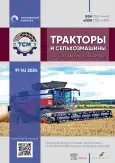Компьютерное моделирование испытаний кабины грузового автомобиля для поиска путей выполнения требований правил ООН 29
- Авторы: Сергиевский С.А.1, Трусова Ю.П.1, Морозова А.А.1, Макаров В.С.1, Шмелев А.А.2, Мансуров Т.Н.2
-
Учреждения:
- Нижегородский государственный технический университет им. Р.Е. Алексеева
- “КАМАЗ”
- Выпуск: Том 91, № 4 (2024)
- Страницы: 450-465
- Раздел: Теория, конструирование, испытания
- URL: https://bakhtiniada.ru/0321-4443/article/view/269913
- DOI: https://doi.org/10.17816/0321-4443-632953
- ID: 269913
Цитировать
Полный текст
Аннотация
Обоснование. Обеспечение требуемого уровня пассивной безопасности грузовых автомобилей является актуальной задачей. Для решения этой задачи необходимо применение методов компьютерного моделирования.
Цель работы — поиск путей обеспечения пассивной безопасности грузовых автомобилей за счёт выбора соответствующей конструкции кабины.
Методы. При проведении исследования применялся метод виртуального моделирования испытаний кабины грузового автомобиля в соответствии с требованиями Правил ООН 29.
Результаты. Разработана расчётная модель кабины грузового автомобиля, позволяющая выполнять компьютерное моделирование испытаний по Правилам ООН 29. Основным требованием Правил ООН 29 является сохранение после проведения испытаний пространства в кабине, достаточного для размещения в нём манекена водителя. В рамках исследования проведено определение свойств материала (стали), используемого для изготовления кабин-прототипов разрабатываемого автомобиля, причём испытанные образцы были получены путём препарирования изделия-прототипа, то есть полученные результаты учитывают технологическую историю материала. Полученные данные о свойствах материалов использовались при разработке расчётной модели кабины. В разработанной и используемой расчётной модели учтены все особенности конструкции исследуемой кабины, в том числе расположение и характеристики сварочных точек. Исследованы различные варианты изменений конструкции кабины и их влияние на возможность выполнения требований Правил ООН 29. Установлено, что только увеличением (в разумных пределах) толщины отдельных элементов каркаса кабины и/или применения для их изготовления высокопрочной стали обеспечить выполнение требований Правил ООН № 29 в полном объёме не удаётся. На основе анализа деформации каркаса кабины-прототипа при приложении к ней нагрузки, соответствующей Испытанию C по Правилам ООН № 29 Пересмотр 2, сформулированы предложения по изменениям конструкции кабины, позволяющие выполнить требование Правил ООН № 29.
Заключение. Результаты исследования указывают на перспективность предлагаемых изменений конструкции кабины.
Полный текст
Открыть статью на сайте журналаОб авторах
Сергей Андреевич Сергиевский
Нижегородский государственный технический университет им. Р.Е. Алексеева
Email: s.sergievskiy@nntu.ru
ORCID iD: 0000-0003-4944-4254
SPIN-код: 8555-4440
канд. техн. наук, доцент кафедры «Автомобили и тракторы»
Россия, 603155, Нижний Новгород, ул. Минина, д. 24Юлия Павловна Трусова
Нижегородский государственный технический университет им. Р.Е. Алексеева
Email: trusovayp@nntu.ru
ORCID iD: 0000-0001-6715-3739
ведущий инженер Центра технических средств и технологий мониторинга окружающей среды
Россия, 603155, Нижний Новгород, ул. Минина, д. 24Анастасия Александровна Морозова
Нижегородский государственный технический университет им. Р.Е. Алексеева
Email: anastasia.smirnova96@mail.ru
ORCID iD: 0000-0001-8787-2861
ведущий инженер Центра технических средств и технологий мониторинга окружающей среды
Россия, 603155, Нижний Новгород, ул. Минина, д. 24Владимир Сергеевич Макаров
Нижегородский государственный технический университет им. Р.Е. Алексеева
Автор, ответственный за переписку.
Email: makvl2010@gmail.com
ORCID iD: 0000-0002-4423-5042
SPIN-код: 9834-6239
д-р техн. наук; профессор кафедры «Строительные и дорожные машины»
Россия, 603155, Нижний Новгород, ул. Минина, д. 24Александр Александрович Шмелев
“КАМАЗ”
Email: ShmelevAA@kamaz.ru
ORCID iD: 0009-0004-2809-6945
SPIN-код: 6112-6322
инженер-конструктор НТЦ
Россия, Набережные ЧелныТимур Наилович Мансуров
“КАМАЗ”
Email: MansurovTN@kamaz.ru
ORCID iD: 0009-0000-7468-2073
SPIN-код: 3133-6306
инженер-конструктор НТЦ
Россия, Набережные ЧелныСписок литературы
- ГОСТ Р 41.29-99. Единообразные предписания, касающиеся официального утверждения транспортных средств в отношении защиты лиц, находящихся в кабине грузового транспортного средства. Дата обращения 05.04.2024. Режим доступа: https://docs.cntd.ru/document/1200027818
- UN Regulations (Addenda to the 1958 Agreement). Дата обращения 09.04.2024. Режим доступа: https://unece.org/un-regulations-addenda-1958-agreement.
- OОО “Европейская металлургическая компания” [internet] Дата обращения 22.03.2024. Режим доступа: https://emk24.ru/wiki/en_steels/s500mc_1_0984_2186665.
- Ratzel M., Bois P.D., Fredriksson L.A., Schneider D. A study of mesh sensitivity for crash simulations: comparison of manually and batch meshed models. In: LS-DYNA Anwenderforum. Bamberg, 2005. Дата обращения: 05.04.2024. Режим доступа: https://citeseerx.ist.psu.edu/document?repid=rep1&type=pdf&doi=4fe74feb189b614c2aa495d4cdaadda2217beb60
- Шмелев А.В., Лисовский Э.В., Короткий В.С. Основы методики виртуального моделирования испытаний кабин грузовых автомобилей по требованиям пассивной безопасности // Механика машин, механизмов и материалов. 2015. Т. 33, № 32. Дата обращения 01.09.2024. Режим доступа: https://mmmm.by/pdf/ru/2015/03/9.pdf
- Орлов Л.Н., Рогов П.С., Тумасов А.В., Вашурин А.С. Повышение пассивной безопасности кузовов автобусов // Современные проблемы науки и образования. 2014. № 3. Дата обращения 22.03.2024. Режим доступа: https://science-education.ru/ru/article/view?id=13019
- Зузов В.Н., Шабан Б. Совершенствование кабин грузовых автомобилей на стадии проектирования для удовлетворения требованиям пассивной безопасности // Инженерный журнал: наука и инновации. 2013. Вып. 12. Дата обращения 22.03.2024. Режим доступа: http://engjournal.ru/catalog/machin/transport/1130.html.
Дополнительные файлы
































